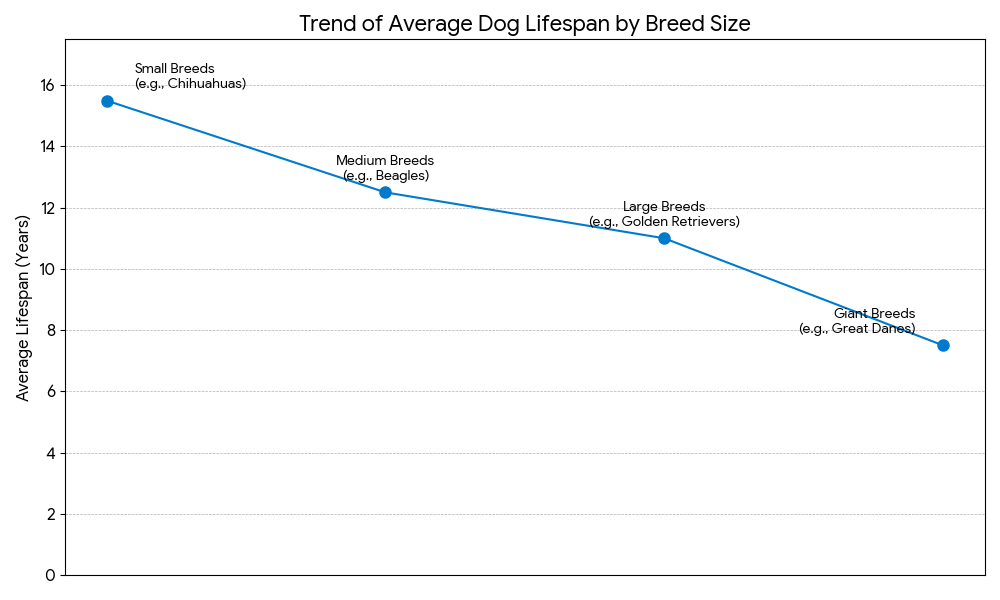A Comprehensive Guide to Canine Lifespans
How Long Will My Dog Live? Understanding the Factors of Longevity
As devoted dog owners, we share a universal wish: that our furry companions could live as long as we do. While that may not be possible, understanding the typical lifespan of your dog’s breed can profoundly enrich the time you have together. It allows you to appreciate each life stage, from playful puppyhood to the dignified calm of their senior years, and empowers you to provide the best possible care to maximize their health and longevity.
A dog’s lifespan is a complex tapestry woven from genetics, size, lifestyle, and the quality of care they receive. While no one can predict the future with certainty, decades of veterinary data have given us clear insights into the average life expectancy for hundreds of different breeds.
This comprehensive guide features a database of over 150 dog breeds. Use the interactive tool below to select your dog’s breed and discover their average expected lifespan. This knowledge is a powerful tool for any responsible dog owner, helping you plan for their future and cherish every moment.
Find Your Dog's Breed Lifespan
The Biggest Factor: Why Size Matters for Lifespan
One of the most consistent findings in canine science is the inverse relationship between size and lifespan. In the animal kingdom, this is a strange anomaly—typically, larger mammals like elephants and whales live much longer than smaller ones like mice. But in the world of dogs, the opposite is true.
- Small Breeds (e.g., Chihuahuas, Dachshunds, Toy Poodles): Often live well into their teens, with many reaching 15, 16, or even more years. The longest-living dogs are almost always small breeds.
- Medium Breeds (e.g., Beagles, Border Collies): Generally have a lifespan in the range of 11 to 14 years.
- Large Breeds (e.g., Golden Retrievers, German Shepherds): Typically live for 10 to 12 years.
- Giant Breeds (e.g., Great Danes, Irish Wolfhounds, Mastiffs): Have the shortest lifespans, often averaging only 6 to 9 years.

Scientists believe this occurs because giant breeds grow incredibly fast, which may lead to a higher incidence of abnormal cell growth and a quicker onset of age-related diseases.
Beyond Size: Other Key Factors in Your Dog’s Longevity
While size is a major predictor, several other crucial elements contribute to how long your dog will live.
Genetics and Breed-Specific Health
A dog’s genetic code is a primary blueprint for its health. Purebred dogs are often predisposed to certain hereditary conditions. For example, Cavalier King Charles Spaniels are prone to heart conditions, while German Shepherds can be susceptible to hip dysplasia. Responsible breeders conduct genetic testing to screen for these issues, which is why choosing a reputable breeder is so important. Mixed-breed dogs, with their more diverse gene pool, often benefit from “hybrid vigor,” which can sometimes lead to a longer, healthier life by reducing the risk of inheriting breed-specific diseases.
Lifestyle and Preventative Care
This is the area where you, as an owner, have the most influence. The daily choices you make have a massive impact on your dog’s lifespan.
- Nutrition: A high-quality, balanced diet appropriate for their life stage provides the building blocks for a healthy body and strong immune system. Keeping your dog at a lean, healthy weight is one of the most effective ways to extend their life, as it reduces stress on their joints, heart, and other organs.
- Exercise: Regular physical activity keeps muscles strong, joints healthy, and prevents obesity. Equally important is mental exercise—puzzle toys, training, and new experiences keep their minds sharp and prevent boredom.
- Veterinary Care: Proactive, preventative care is essential. Annual wellness exams, regular vaccinations, consistent dental care, and year-round flea, tick, and heartworm prevention can stop many serious diseases before they start.
By understanding the interplay of these factors, you can become the best possible advocate for your dog’s health, giving them the greatest chance at a long, happy, and vibrant life by your side.
This guide provides data-based averages for educational purposes and is not a guarantee of any individual dog’s lifespan. Every dog is unique.